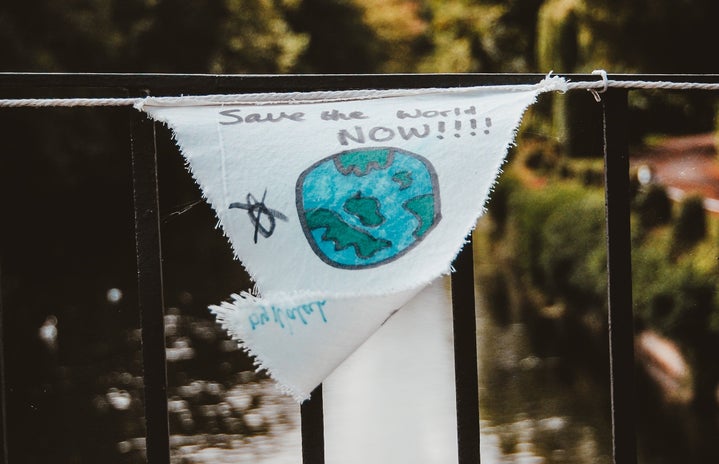The experience is a powerful one. The room is perfectly unassuming and silent, filled with stories and outfits ranging from sweats, cargo shorts to mini dresses, sleep shirts to child-sized princess dresses.
The outfits were assembled as part of an installation called “What Were You Wearing?” which opened Sept. 5 at the Kansas Union Gallery at University of Kansas. It’s a display of what survivors were wearing when their assaults took place.
For viewers used to sculpture and canvas, it’s quite surprising to peer in the open doors and see everyday clothes pinned to the wall. But upon closer inspection you’ll find that the mundane, ordinary nature of the collection is exactly the point.
Beside each piece is a card written by an anonymous survivor of sexual assault, explaining how the outfits have a unique connection to their experiences. The doors feature a trigger warning for the emotional experience and tissues are provided throughout the room.
The exhibit is a direct response to the loaded question people often ask rape survivors: “What were you wearing?” The clothes, displayed together alongside the voices of survivors and victims seem to respond, “What does it matter?”
Social worker and KU alum Jacey Bishop told Her Campus that the questions about a survivor’s attire during their assault contributes to a culture that blames and shames victims of these traumatic experiences.
“By asking a victim what they were wearing the night of their assault, we are shifting the blame away from the perpetrator and to the victim,” Bishop said. “Psychologically, this has detrimental effects. Suddenly, the victim will start to question themselves and think ‘Maybe if I did this’ or ‘Maybe if I didn’t do this,’ then it wouldn’t have happened.”
However, Bishop, who currently works at a mental health center and domestic violence shelter in Overland Park, Kansas, said that the culture needs to reframe conversations about sexual assault to fault the assailants and not the victims.
“The detrimental effects that self-blame can have on a person leads to a long line of traumatizing mental illness, whether it be depression, PTSD, anxiety, phobias, etc. The conversation cannot be about what a victim did wrong, it needs to be about the perpetrator what they did wrong.”
“What Were You Wearing?” first made an appearance in 2013 at the University of Arkansas and has circulated a few other campuses in the Midwest before landing at KU, according to the Lawrence Journal World. A committee of students representing KU Student Union Activities and the KU Sexual Assault Prevention and Education Center chose from an array of 40 stories and corresponding clothing.
Their choices reflect the different ages and backgrounds of survivors that mimic the community we have here at KU. The message is clear: This is a problem that spans far beyond class, age, race and even gender.
The exhibit encourages students to share their own stories and descriptions of what they were wearing in a private booth in the corner of the room. By asking for active and anonymous participation, the exhibit will be allowed to expand before moving on to other campuses.
“I was surprised that they would be doing this at the Union because I think a lot of students feel as though there’s not enough being done to bring awareness to the issue or to help survivors,” Haley Rowe, a junior at the University of Kansas, told Her Campus.
This past January, KSHB 41 Action News reported on three incidents of sexual assault happening within three months. Police investigators looked into the accusations, all of which took place in KU dorms, and made arrests accordingly. The question still stands, however, on how we can avoid these incidents in the first place.
“There are resources available, but I think it needs to be more of a social conversation and it needs to be an ongoing conversation,” Rowe said. “There’s sexual assault training that we go through and we try to educate students on consent, but I feel like there needs to be more mandatory in-person conversations. I don’t know how much an online assessment really does for people.”
Lauren Jackson-Davenport isn’t a student at the University of Kansas, but her sister is an incoming freshman. She told Her Campus that she came to view the installation after her mother heard about it on the morning news and she read an article online detailing what is featured.
“I am a little concerned [for my sister] because she is so far away. We live in Michigan and she’s here,” Jackson-Davenport said. “You don’t want it to happen, but you have to make sure you keep an eye out for her. We usually keep in contact when she’s out of the building by herself.”
Jackson-Davenport goes to Central Michigan University and said she would welcome a similar exhibit on her own campus — and that it should be welcome everywhere.
“People have this thing where they think it’s something you wear or what you do,” she said. “It’s not. No matter what you wear or what you’re doing, it can happen any time or at any place.”
[Images: Courtesy of Hannah Strader, rogamuffin slutwalk-30.jpg via photopin (license)]


